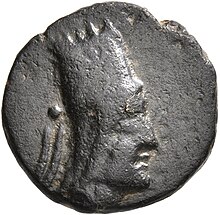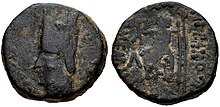Tigranes I
| Tigranes I | |
|---|---|
| Great King | |
 Coin of Tigranes I | |
| King of Armenia | |
| Reign | 120 – 95 BC (disputed) |
| Predecessor | Artavasdes I |
| Successor | Tigranes II the Great |
| Died | 95 BC |
| Issue | Two sons: Tigranes II Guras |
| House | Artaxiad |
| Father | Artaxias I |
| Mother | Satenik(?) |
Tigranes I(Ancient Greek:Τιγράνης) was anArtaxiadking ofArmeniaat the end of the 2nd and the beginning of the 1st century BC. Few records have survived about his and his predecessorArtavasdes I's reign, which has led to some confusion.[1]Some modern scholars have doubted that such a king reigned at all.[2][3]Other historians, such asHakob Manandian,David Marshall LangandRouben Paul Adalianconsider him a real figure but differ or are uncertain on the exact dates of his reign.[4][5][6][7][8][9][10]Although it has been proposed that Tigranes I reigned from 123 BC to 96 BC,[9][11]this view has been criticized.[3]Another suggestion is that Tigranes I ruled in 120 BC - 95 BC and this has been recently corroborated by historian Christian Marek.[5][12]
Name[edit]
The nameTigránēs(Τιγράνης) is theGreekform ofOld IranianTigrāna(TigranՏիգրանinArmenian).[13]The exact etymology is disputed but it is likely an Old Iranian patronymic formation of the suffix*-āna-and the name*Tigrā-(meaning'slender').[14][15]The Armenian historianMovses Khorenatsimentions aTiran,"son of Artaxias and brother of Artavasdes", who has been identified as Tigranes I.[4][16][17]
Background[edit]
Tigranes I is assumed to be the fourth oldest son of five betweenArtaxias IandSatenik.[according to whom?]He ascended to the throne due toArtavasdes Inot having an available heir, as well as his other brothers being kicked out of the royal estates by Artavasdes I.[18][19][4][20][1][8]He was madesparapet(commander) over the western army byArtaxias I.[18]
After the departure of Artaxias's most trusted general, Smbat Bagratuni, Tigranes's brother, Mazhan, requested King Artaxias that Artavasdes's and Tigranes's roles be stripped from the army and instead be entrusted to Zariadres. Artaxias rejected the request and Mazhan began plotting against Tigranes. However, Artavasdes and Tigranes caught wind of the plot and ambushed and killed Mazhan during a hunting trip. They then buried him atBagaran.[18]
Seleucid and Iberian invasion[edit]
In 165/4 BC, theSeleucidarmy, led byAntiochus IV Epiphanes,invaded Armenia and defeated Tigranes's army, forcing him to retreat toBasenand await aid from Artavasdes I and Smbat Bagratuni. Eventually the Armenian army defeated the Seleucid army, which had to return toSyriadue to internal troubles at home.[18]Tigranes's brother, Zariadres was captured after a defeat inJavakhk,three years later Tigranes, Artavasdes, and Smbat marched towardsTrialeti,but negotiate for Zariadres's freedom, as well as scoring an alliance with theIberian kingdomwhile ceding Javakhk andArdahan.[21][18]
Parthian invasion[edit]
In 120 BC, theParthiankingMithradates IIinvaded Armenia. Artavasdes I was forced to give Tigranes's son, the futureTigranes II the Great,toMithradates IIas a hostage and recognize Parthian suzerainty over Armenia.[22][23]

Reign[edit]
In 120 BC, after the death of Artavasdes I, Tigranes I ascended the throne.[5][12]Hakob Manandian,citingStrabo,mentions that Tigranes I put up a strong resistance against the Parthians and successfully defended Armenia and faced no conflict afterwards.[24][25]He also stripped theVahevunisof their priesthood after finding out that they had moved the gold plated statue ofVahagnlocated inArmavirto their domain inAshtishatafter the death ofArtaxias I.[26][27][18]
Tigranes entered into a rivalry with aBznuniprince named Datake, who boasted that he was richer than the king. Tigranes also had to deal with the inheritance issues of his and other families, as his relatives living in the region ofHashteankcomplained that there was not enough land to divide among themselves. Tigranes told them to move toAghiovitor Arberan; however, they protested. Eventually Tigranes told them that they either move to Arberan or Aghiovit or split what they had among themselves. Seeing that not enough land could be split among themselves in Hashteank, some of the Artaxiads moved.[18]
Tigranes also gave away Artavasdes's holdings to anAndzevatsiprince named Erakhnavu, who was a distinguished man and had married the last of Artavasdes's wives. He was eventually made second rank andsparapetof the eastern army. He also took care of Druasp, aPersianfriend who had become related by marriage to the princes ofVaspurakanand was given the town ofTateawnand its estates, andvineyardsas well as establishing his court in the town of Chrmes in the region ofEkegheats.[18]
Tigranes married his daughter Eraneak to a man named TrdatBagratuni,who was the son of Smbatuhi, the daughter of Smbat Bagratuni. Eraneak hater her husband, complaining about Trdat's ugly appearance. This angered Trdat and he beat Ereneak severely, dragging her outside. He then entered in rebellion to secure the regions ofMedia;however, upon arriving inSyunik,he received the news of Tigranes's death and ended the rebellion. Tigranes died in a snowstorm in around 95 BC.[18]
After his death, Tigranes II, who was given as hostage to the Parthians by Artavasdes I, returned from his captivity in Parthia and assumed the throne.[28]According toAppian,Tigranes II was the son Tigranes I.[29]This view has also been supported by modern research.[4][20][1][30]
Barring the conflict with Parthians, the reign of Tigranes I has been described as generally peaceful and devoid of major external events.[31]
Coinage[edit]

According to Kovacs, only three types of coins have been attributed to Tigranes I, all with the Greek inscriptionΒΑΣΙΛΕΩΣ ΜΕΓΑΛΟΥ ΤΙΓΡΑΝΟΥ('King Tigranes the Great') and depicting Tigranes I wearing afive-pointed tiara.The reverses of these coins either depicts an eagle standing, a cornucopia with a grape cluster, or a thunderbolt.[32]

Following the death of Tigranes I, his son Tigranes II proclaimed him as a god and minted coins with his image and the inscriptionΒΑΣΙΛΕΩΣ ΜΕΓΑΛΟΥ ΤΙΓΡΑΝΟΥ ΘΕΟΥ('King Tigranes the Great and Divine'). Six of these coins were issued, three of which being minted inArtaxataand the other three minted inTigranocerta.The reverses of these coins either depict an elephant, horse, lion, or the goddessNikeholding a wreath or palm.[32]

Some numismatists such as Bedoukian and Nupertlian have argued that the coins depicting a crude bust of a beardless king facing left is attributed to Tigranes I.[35][36][34]However, Kovacs attributes them to Tigranes II, citing the regnal year visible on the reverse. They were also minted inNisibis,which was not under Armenian control during the time of Tigranes I.[32][33]
Family[edit]
Tigranes I had four brothers: his predecessor Artavasdes I, Zariadres, Vruyr and Mazhan.[37]AlthoughAlanprincessSatenikhas been shown to be Artaxias I's wife,[38]there is no concrete evidence that she was their mother.
Tigranes I had two sons and a daughter, his successor Tigranes II (r. 95–55 BC) and Guras, who is mentioned byPlutarchas the governor ofNisibis,and Eraneak, who was married off to Trdat Bagratuni.[39][40][41][18]Guras was later captured byRomangeneralLucullus.[39]Judging by Roman authorLucian'sMacrobii,Tigranes II was born to Tigranes I inc.140 BC.[42][43][failed verification]
References[edit]
- ^abcGarsoïan 1997,p. 52.
- ^Foss 1986,p. 48.
- ^abSullivan 1973,p. 25.
- ^abcdManandian 1945,p. 135.
- ^abcSchottky 1989,p. 242.
- ^de Morgan 1965,p. 402.
- ^Lang 1980,p. 125.
- ^abAdalian 2010,p. 19.
- ^abBedoukian 1978,p. 9.
- ^Nercessian 1995,p. 55.
- ^Garsoïan 1997,p. 62.
- ^abMarek 2016,p. 570.
- ^Acharian 1942,p. 146-147.
- ^Tavernier 2007,p. 324.
- ^Schmitt 2005.
- ^Nahapetyan 2017,p. 70.
- ^Movses Khorenatsi,Գիրք Բ. ԿԱ.
- ^abcdefghijMoses, of Khoren, activeth century (1978).History of the Armenians.Robert W. Thomson. Cambridge: Harvard University Press.ISBN0-674-39571-9.OCLC3168093.
{{cite book}}:CS1 maint: multiple names: authors list (link) - ^Bedoukian 1968,p. 43.
- ^abManandian 2007,p. 19.
- ^The Georgian chronicles of Kʻartʻlis Cʻxovreba (A History of Georgia): translated and with commentary.Stephen Jones, Roin Metreveli, Sakʿartʿvelos mecʿnierebatʿa akademia. Komissii︠a︡ po istochnikam istorii Gruzii. Tʻbilisi. 2014.ISBN978-9941-445-52-1.OCLC883445390.
{{cite book}}:CS1 maint: location missing publisher (link) CS1 maint: others (link) - ^Højte, Jakob Munk (2009).Mithridates VI and the Pontic Kingdom.Santa Barbara: Aarhus University Press.ISBN978-87-7934-655-0.OCLC818118033.
- ^Garsoïan, Nina (2005)."TIGRAN II".Encyclopaedia Iranica Online.doi:10.1163/2330-4804_eiro_com_1382.Retrieved2023-03-03.
- ^Manandian 1945,p. 134-135.
- ^Strabo,XVI 19.
- ^Movses Khorenatsi,Գիրք Բ. ԺԲ-ԺԴ.
- ^Margaryan 2018,p. 295.
- ^Garsoïan 1997,p. 54.
- ^Appian,The Syrian Wars. 48.
- ^Redgate 2000,p. 77.
- ^Aghayan 1971,p. 551.
- ^abcdefKovacs, Frank L. (2016).Armenian coinage in the classical period.Lancaster, Pennsylvania.ISBN978-0-9837652-4-0.OCLC956380761.
{{cite book}}:CS1 maint: location missing publisher (link) - ^abNurpetlian, Jack."Ancient Armenian Coins, the Artaxiad Dynasty (189 BC - AD 6).pdf".
{{cite journal}}:Cite journal requires|journal=(help) - ^abBedoukian 1968,p. 52.
- ^Bedoukian 1968,p. 58.
- ^Bedoukian 1978,p. 10.
- ^Sargsyan 1991,p. 51.
- ^Margaryan 2018,p. 292.
- ^abPlutarch,Volume 3. page 270.
- ^Encyclopedia Iranica,Tigran II.
- ^Kurk gian 1958,p. 82.
- ^Lucian.Macrobii,15.
- ^Encyclopedia Britannica,Tigranes II The Great.
Bibliography[edit]
- (in English)
- Adalian, Rouben Paul(2010).Historical Dictionary of Armenia.Lanham, MD:Scarecrow Press.pp. 1–750.ISBN9780810874503.
- Bedoukian, Paul Z. (1978).Coinage of the Artaxiads of Armenia.London:Royal Numismatic Society.pp. 1–81.ISBN9781886720039.
- Bedoukian, Paul Z. (1968). "A Classification of the Coins of the Artaxiad Dynasty of Armenia".Museum Notes (American Numismatic Society).14.American Numismatic Society:41–66.
- de Morgan, Jacques(1965).The History of the Armenian People.Hairenik Press.

- Foss, Clive (1986). "The Coinage of Tigranes the Great: Problems, Suggestions and a New Find".The Numismatic Chronicle.146.Royal Numismatic Society:19–66.ISSN0078-2696.
- Kurk gian, Vahan(1958). "XIII: Tigran the Great".A history of Armenia.Armenian General Benevolent Union.pp. 74–84.

- Garsoïan, Nina(1997)."The Emergence of Armenia".In Hovannisian, Richard G. (ed.).The Armenian people from ancient to modern times.Vol. 1.New York:St. Martin's Press.pp. 37–60.ISBN978-0-312-10169-5.

- Lang, David M.(1980).Armenia: Cradle of Civilization.Allen & Unwin.pp. 1–320.ISBN978-0049560093.
- Manandian, Hakob(2007).Tigranes II and Rome: a new interpretation based on primary sources.Mazda Publishers. pp. 1–201.ISBN978-1568591667.
- Marek, Christian (2016).In the Land of a Thousand Gods: A History of Asia Minor in the Ancient World.Princeton University Press.ISBN978-0691159799.
- Nercessian, Y. T. (1991)."An Unpublished Coin of Tigranes I"(PDF).Patma-Banasirakan Handes.XVII.Armenian Numismatic Society:12–21.ISSN0135-0536.

- Nercessian, Y. T. (1995).Armenian coins and their values.Armenian Numismatic Society.pp. 1–254.ISBN9780960684281.
- Redgate, Anne Elizabeth(2000).The Armenians.Wiley–Blackwell.ISBN9780631143727.
- Schmitt, Rüdiger (2005)."Personal Names, Iranian iv. Parthian Period".Encyclopaedia Iranica.
- Sullivan, R. D. (1973). "Diadochic Coinage in Commagene After Tigranes the Great".The Numismatic Chronicle.13.Royal Numismatic Society:18–39.ISSN0078-2696.
- Tavernier, Jan (2007).Iranica in the Achaemenid Period (ca. 550-330 B.C.): Lexicon of Old Iranian Proper Names and Loanwords, Attested in Non-Iranian Texts.Peeters Publishers. pp. 1–201.ISBN978-9042918337.
- (in Armenian)
- Acharian, Hrachia(1942).Հայոց անձնանունների բառարան (Dictionary of Armenian Proper Names)(in Armenian).Yerevan:Yerevan State University.

- Aghayan, Eduard, ed. (1971). "5: Հայաստանը հելլենիստական ժամանակաշրջանում։ Ստրկատիրական հասարակարգի զարգացումը".Հայ Ժողովրդի Պատմություն (History of Armenian people)(in Armenian). Vol. 1.Yerevan:ՀՍՍՀ ԳԱ հրատ. pp. 498–712.

- Manandian, Hakob(1945). "9: Արտաշեսյան և Զարեհյան թագավորությունների հաստատումը Հայաստանում".Քննական Տեսություն Հայ Ժողովրդի Պատմության (Critical Survey of the History of the Armenian People)(in Armenian). Vol. 1.Yerevan:Հայպետհրատ. pp. 114–138.

- Margaryan, Hasmik Z. (2018)."Արտաշես Ա արքայի Արտամատ քաղաքը՝ ըստ Թովմա Արծրունու" Արծրունյաց տան պատմության "(The City of Artashes I Artamat, according to" The History of the House of Artsruni "by Tovma Artsruni)".Lraber Hasarakakan Gitutyunneri(in Armenian).1.Yerevan:Armenian National Academy of Sciences:285–300.ISSN0320-8117.

- Nahapetyan, Rafik A. (2017)."Ապպիանոսի" Հռոմեական պատմություն "երկը՝ հայոց պատմության և մշակույթի կարևոր սկզբնաղբյուր (Appian's WorkRoman Historyas an Important Source for the Armenian History and Culture) ".Lraber Hasarakakan Gitutyunneri(in Armenian).2.Yerevan:Armenian National Academy of Sciences:70–80.ISSN0320-8117.

- (in Russian)
- Sargsyan, Gagik(1991)."Свидетельство поздневавилонской клинописной хроники об Армении времени Тиграна II (An Evidence About Armenia of Tigran II' s Period in the Late-Babylonian Cuneiform Chronicle)".Patma-Banasirakan Handes. Istoriko-Filologicheskii Zhurnal(in Russian).2.Patma-Banasirakan Handes:45–54.ISSN0135-0536.

- (in German)
- Schottky, Martin (1989).Media Atropatene und Gross-Armenien in hellenistischer Zeit(in German).Bonn:Habelt.ISBN9783774923942.
